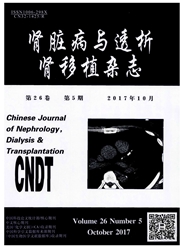

 中文摘要:
中文摘要:
目的:观察2型糖尿病肾病(DN)合并IgA肾病(IgAN) (DN+IgAN)患者的临床、病理及预后特征.方法:回顾性分析临床诊断为2型糖尿病并经肾活检明确诊断,且随访≥1年的患者.按照Tervaet等提出的病理分型标准进行分型,并对DN、IgAN常见的病理改变进行评估.随访终点定义估算的肾小球滤过率(eGFR)<15ml/(min· 1.73m2). 结果:本研究共纳入病理确诊DN+IgAN的患者50例,其中男性34例,女性16例,肾活检时平均年龄47.6±11.2岁,418例病理确诊DN且不合并非糖尿病肾脏病变的患者为对照组.DN+IgAN患者的肾活检前中位糖尿病病程短于DN患者(44月vs 84月,P=0.005),两组发病年龄、男女比例、肾脏病病程无明显差异.肾活检时DN+IgAN患者的中位尿蛋白定量0.81 g/24h,64.0%患者尿蛋白定量<1g/24h,仅12.0%患者尿蛋白定量≥3.5 g/24h,而41.1%DN患者尿蛋白定量<1 g/24h,23.4%患者尿蛋白定量≥3.5 g/24h,两组差异显著(P=0.008).两组的肾功能水平无差异.DN+IgAN患者的高血压、视网膜病变发生率分别为66.0%和24.0%,均低于DN患者.DN+IgAN患者肾小球病变以Ⅱa期(68.0%)为主,而DN患者以Ⅲ期(40.0%)为主(P<0.001).DN+IgAN患者的肾小球节段硬化和新月体的发生率分别为66.0%和28.0%,显著高于DN患者(P<0.001),而无肾小管的肾小球、结节性硬化、微血管瘤、透明滴/纤维帽、纤维素样渗出等DN典型病变发生率均低于DN患者.采用1∶1配对病例对照研究的方法,筛选出与DN+IgAN患者肾活检时年龄、性别、临床表现、病理表现一致的DN患者作为对照,经Kaplan-Meier法统计,DN+IgAN与DN患者的预后无差异. 结论:DN+IgAN组患者与不合并IgAN者相比,糖尿病病程较短,蛋白尿水平低,高血压、糖尿病视网膜病变发生率较低,肾小球病变较轻,同时伴IgAN的一些病理特点.DN+IgAN患者的预后与不合并IgAN者无显著?
 英文摘要:
英文摘要:
Objective: To observe the clinicopathologic features and prognostic of the patients with IgA nephropathy superimposed on diabetic nephropathy (DN+IgAN). Methodology:Patients with T2DM and renal biopsy from 2003 to 2011 were reviewed. All patients were followed for at least a year after biopsy. All renal biopsies were reviewed according to the pathologic classification of Tervaert et al. Fifty cases with DN+IgAN were diagnosed, and 418 cases with DN only were enrolled as the control group. A renal event was defined as cGFR 〈 15 ml/( min. 1.73m2 ). Their clinieopathologic features and prognosis were analyzed and compared between two groups. Results:At the time of renal biopsy,the median duration of diabetes was shorter in the DN + IgAN than that in the DN group (44 vs 84 months, P = 0. 005 ), however, the ages, sex ratio and the kidney disease duration of the two groups had no difference. Compared with the DN group, the level of urinary protein excretion 〈1 g/24h in the DN+IgAN was 64. 0% vs 41.1% cases,and 〉3. 5 g/24h was 12% vs 23.4% cases (P= 0. 008). While the renal function had no differences between two groups. Additionally, the rate of hypertension and diabetic retinopathy in the DN+IgAN group was 66.0% and 24.0% respectively, and lower than those in the DN group. Histologically, most patients presented as class II a (68. 0%) in the DN+lgAN group, while as class III (40.0%) in the DN group. The lesion of segmental glomerulosclerosis and crescent formation was 66.0% and 28.0% respectively in the DN+IgAN group, and higher than those in the DN group (P〈0. 001 ). Typical glomerular lesions of DN, such as nodule lesions, microaneurysms, atubular glomeruli, were presented in fewer patients of the DN + IgAN group. Calculated by Kaplan-Meier method, the outcome of the DN + IgAN group had no difference with the DN group. Conclusion: Compared with DN only, the patients with DN + IgAN had shorter duration of diabetes, lower level of proteinuria, fewer with
 同期刊论文项目
同期刊论文项目
 同项目期刊论文
同项目期刊论文
 Long-term renal survival and related risk factors in patients with IgA nephropathy: results from a c
Long-term renal survival and related risk factors in patients with IgA nephropathy: results from a c Orticosteroid therapy in IgA nephropathy with minimal change-like lesions: a single-center cohort st
Orticosteroid therapy in IgA nephropathy with minimal change-like lesions: a single-center cohort st MiR-223 down-regulation promotes glomerular endothelial cell activation by up-regulating importin &a
MiR-223 down-regulation promotes glomerular endothelial cell activation by up-regulating importin &a 期刊信息
期刊信息
